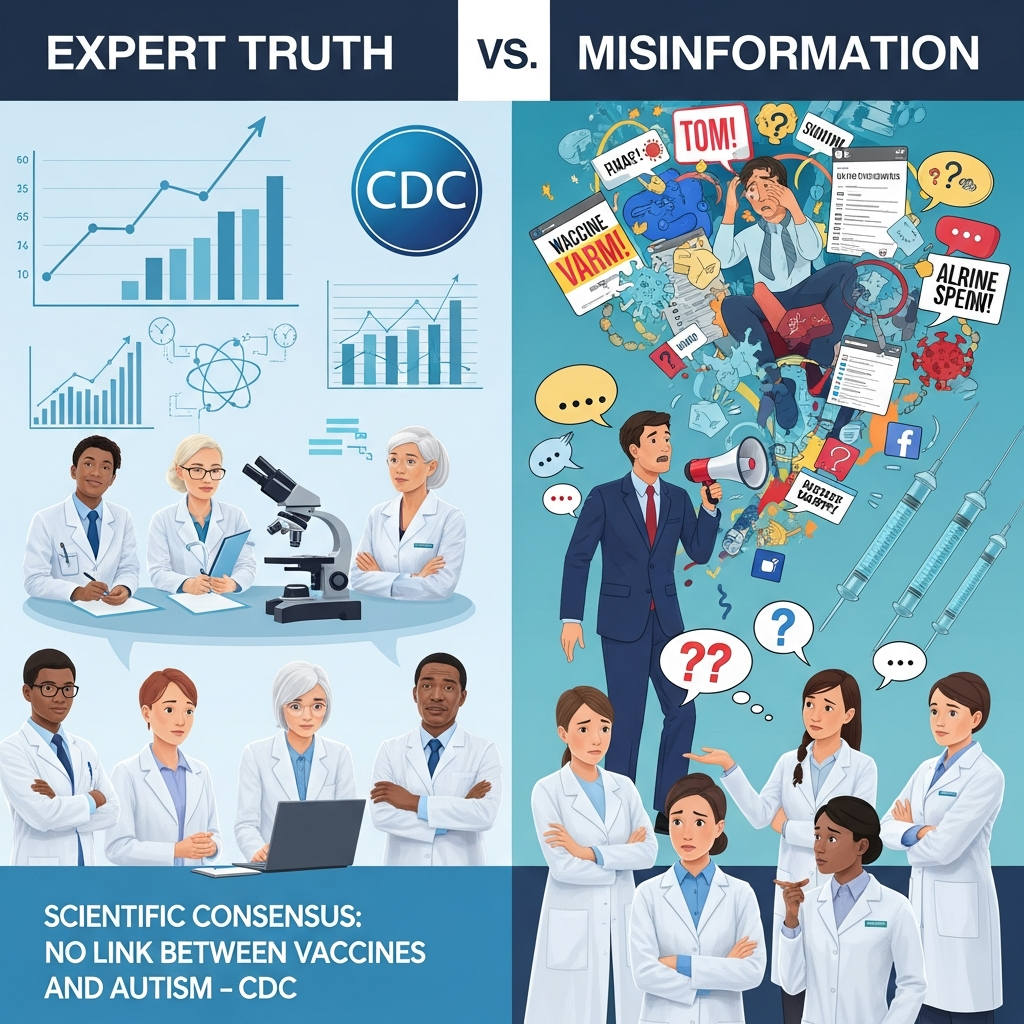Breaking news from Wisconsin confirms the state’s first measles cases of 2025, with nine individuals in Oconto County diagnosed with the highly contagious viral disease. While health officials currently assess the community risk as low, these cases highlight Wisconsin’s unique vulnerability amidst a significant national resurgence of measles. Understanding the situation, recognizing symptoms, and knowing how to protect yourself and your family are more critical than ever.
Wisconsin’s First Measles Cases of 2025 Confirmed
The Wisconsin Department of Health Services (DHS), in collaboration with Oconto County Public Health, recently announced the state’s initial measles cases for the current year. A total of nine individuals in Oconto County have been confirmed to have the disease. One of these cases was definitively identified through state laboratory testing. The remaining eight cases were confirmed based on their clear exposure history to the same source and the subsequent development of classic measles symptoms.
Crucially, all nine confirmed cases are linked to a common source of exposure that occurred during out-of-state travel. This suggests the virus was introduced from outside Wisconsin’s borders. As of now, health officials have not identified any specific public points of exposure within Wisconsin. This information is key to the DHS’s assessment that the immediate risk to the broader community remains low. Despite this, health authorities are actively engaged in notifying any individuals who may have been exposed through contact with the confirmed cases.
Understanding Measles: A Highly Contagious Threat
Measles is not merely a childhood rash; it is one of the most contagious infectious diseases known, posing significant health risks. It spreads with alarming efficiency through the air when an infected person coughs or sneezes. The airborne virus particles can remain suspended in the air for up to two hours, long after the infected person has left a room. This extreme contagiousness means that up to 90% of unvaccinated individuals exposed to the virus are highly likely to contract it.
Symptoms typically begin to appear between 10 to 21 days after exposure. The initial phase often mimics a common cold, characterized by a high fever that can exceed 104 degrees Fahrenheit, a persistent cough, runny nose, and red, watery eyes (conjunctivitis). A distinctive red rash with raised bumps usually emerges three to five days after these initial symptoms. This rash famously starts at the hairline and face, then quickly spreads downwards to the neck, trunk, arms, and legs.
Serious Complications and Hospitalization Risks
While many people associate measles primarily with a rash, the disease can lead to severe and life-threatening complications. These include:
Pneumonia: A common and serious complication, particularly in young children and adults.
Encephalitis: Inflammation of the brain, which can cause brain damage, cognitive issues, and even deafness.
Ear Infections: Can lead to permanent hearing loss.
Diarrhea and Vomiting: Can lead to dehydration.
One in four people who contract measles in the U.S. will require hospitalization due to these complications. In rare but tragic instances, measles can be fatal. The national data for this year is stark, with 169 hospitalizations and three deaths reported across the U.S., underscoring the severe nature of the illness.
The Vital Role of the MMR Vaccine
The primary and most effective defense against measles is the Measles, Mumps, and Rubella (MMR) vaccine. Two doses of the MMR vaccine are cited as 97% effective in preventing the disease. Health guidelines are clear and precise regarding vaccination schedules:
Children: The standard schedule recommends a first dose between 12 and 15 months of age, followed by a second dose between ages four and six years.
Adults: Individuals born before 1957 are generally considered immune due to widespread exposure to measles in earlier generations. However, other adults without laboratory evidence of immunity should receive at least one dose of a measles-containing vaccine.
Travelers: For individuals planning international travel or visiting parts of the U.S. experiencing measles outbreaks, specific recommendations apply. Children aged 6 to 12 months, if facing a high risk of exposure due to travel, are eligible for an early dose of the vaccine. Wisconsin also updated its guidance last year, allowing the booster dose to be administered as soon as one month after the first dose in specific high-risk scenarios.
Health officials consistently emphasize the safety of the MMR vaccine. The potential risks associated with vaccine complications are overwhelmingly outweighed by the severe and often life-threatening risks of contracting measles itself.
Wisconsin’s Vulnerability: Low Vaccination Rates
The appearance of measles cases in Wisconsin is particularly concerning given the state’s struggle with vaccination rates. Wisconsin’s measles vaccination coverage among children is among the lowest in the United States. As of 2023, only 81% of two-year-olds in Wisconsin had received the MMR vaccine. This represents a significant decline from 88% in 2013, illustrating a worrying trend.
Even more troubling, some counties within the state have reported vaccination rates as low as 50%. This stark reality falls far short of the crucial threshold needed for community protection. Public health experts, like Malia Jones, an assistant professor at the University of Wisconsin-Madison, have previously cautioned that a vaccination rate of 95% to 98% is essential to effectively prevent measles outbreaks. Wisconsin is currently “well below” this critical threshold in many areas, leaving the population vulnerable. Last school year, less than 85% of Wisconsin kindergartners were up-to-date on their MMR vaccine, considerably lower than the national average of nearly 93%. This low coverage means a greater risk of widespread outbreaks.
A Broader National and Regional Measles Resurgence
The confirmed cases in Wisconsin are not isolated; they reflect a disturbing national and regional trend. By early July of this year, the number of measles cases nationwide had already reached a 33-year high. The Centers for Disease Control and Prevention (CDC) has even issued a health alert due to the accelerating nationwide measles outbreak. This widespread concern is echoed in Wisconsin’s neighboring states—Michigan, Illinois, Iowa, and Minnesota—all of which had already reported confirmed measles cases before Wisconsin’s announcement.
For instance, Minnesota’s Department of Health website recorded five measles cases this year, including an incident where a child with measles visited the Mall of America in June. New data from the CDC also indicates a decline in MMR vaccination coverage among kindergartners for the 2024-2025 school year, observed in over half of U.S. states. This concerning national picture, coupled with confirmed cases in other states like New Jersey and a possible outbreak in Colorado, underscores the urgent need for heightened public health vigilance and increased vaccination efforts.
What to Do: Protecting Yourself and Your Community
Given the confirmed cases and the broader context of increasing measles activity, proactive steps are essential for Wisconsin residents:
Check Vaccination Status: It is vital for all residents to verify their or their child’s MMR vaccination status. This can typically be done through the Wisconsin Immunization Registry online, or by contacting your healthcare provider or local health department. If you are not up-to-date, consult your doctor about receiving the MMR vaccine.
Be Aware of Symptoms: Familiarize yourself with the symptoms of measles. If you or someone you know develops a fever, cough, runny nose, watery eyes, followed by a spreading red rash, take immediate action.
Contact Your Doctor BEFORE Visiting: If you suspect measles, do not go directly to a clinic, urgent care, or emergency room. Instead, call your doctor’s office or clinic by phone first. This allows healthcare providers to take necessary precautions to prevent potential transmission to other patients and staff.
Isolate Yourself if Symptomatic: If you have symptoms, stay home and avoid public places such as work, school, shopping centers, and public transportation. This helps limit the spread of this highly contagious disease.
Frequently Asked Questions
What are the key symptoms of measles, and how easily does it spread?
Measles typically begins with cold-like symptoms such as a high fever (over 104°F), persistent cough, runny nose, and red, watery eyes. These are usually followed by a characteristic red, bumpy rash that starts on the face and spreads downwards. Symptoms usually appear 10 to 21 days after exposure. Measles is extremely contagious, spreading through airborne particles when an infected person coughs or sneezes. The virus can remain airborne for up to two hours, and up to 90% of unvaccinated individuals exposed to it will become infected.
How can I check my or my child’s measles vaccination status in Wisconsin?
Wisconsin residents can check their or their child’s measles, mumps, and rubella (MMR) vaccination status through the Wisconsin Immunization Registry (WIR) online. Alternatively, you can contact your personal healthcare provider’s office or your local county health department. They will have access to your immunization records and can advise if you or your child are up-to-date on the MMR vaccine or if additional doses are recommended.
What immediate steps should I take if I suspect I have measles symptoms?
If you suspect you or a family member has measles symptoms, it is crucial to stay home and avoid all public places, including work, school, shopping centers, and public transportation. Most importantly, do not go directly to a doctor’s office, clinic, or emergency room*. Instead, call your healthcare provider by phone first. This allows medical staff to prepare for your arrival, take necessary precautions to prevent further spread of the virus to other patients and staff, and guide you on the next steps for evaluation and care.
Conclusion: Vigilance and Vaccination are Key
The confirmation of Wisconsin’s first measles cases in Oconto County serves as a critical reminder of the ongoing public health challenge posed by this preventable disease. While the immediate risk to the broader community is deemed low due to the contained nature of these initial cases, the underlying vulnerability stemming from low vaccination rates across the state remains a serious concern. As measles continues its resurgence nationally, proactive measures—especially ensuring up-to-date MMR vaccination—are the most powerful tools we have to protect individual health and prevent larger outbreaks in Wisconsin. Stay informed, stay vigilant, and get vaccinated.



